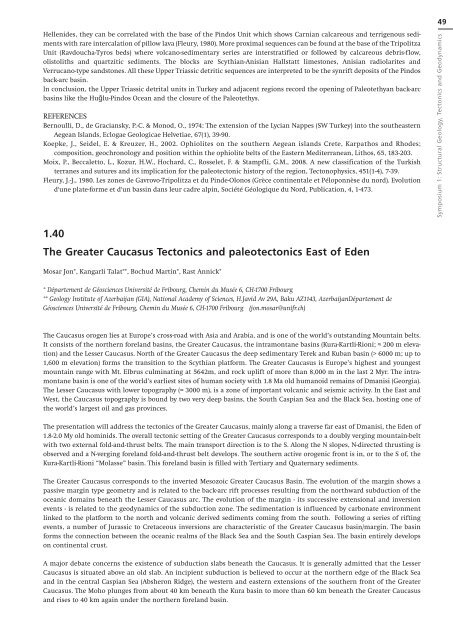Open Session - SWISS GEOSCIENCE MEETINGs
Open Session - SWISS GEOSCIENCE MEETINGs
Open Session - SWISS GEOSCIENCE MEETINGs
Create successful ePaper yourself
Turn your PDF publications into a flip-book with our unique Google optimized e-Paper software.
Hellenides, they can be correlated with the base of the Pindos Unit which shows Carnian calcareous and terrigenous sediments<br />
with rare intercalation of pillow lava (Fleury, 1980). More proximal sequences can be found at the base of the Tripolitza<br />
Unit (Ravdoucha-Tyros beds) where volcano-sedimentary series are interstratified or followed by calcareous debris-flow,<br />
olistoliths and quartzitic sediments. The blocks are Scythian-Anisian Hallstatt limestones, Anisian radiolarites and<br />
Verrucano-type sandstones. All these Upper Triassic detritic sequences are interpreted to be the synrift deposits of the Pindos<br />
back-arc basin.<br />
In conclusion, the Upper Triassic detrital units in Turkey and adjacent regions record the opening of Paleotethyan back-arc<br />
basins like the Huğlu-Pindos Ocean and the closure of the Paleotethys.<br />
REFERENCES<br />
Bernoulli, D., de Graciansky, P.-C. & Monod, O., 1974: The extension of the Lycian Nappes (SW Turkey) into the southeastern<br />
Aegean Islands, Eclogae Geologicae Helvetiae, 67(1), 39-90.<br />
Koepke, J., Seidel, E. & Kreuzer, H., 2002. Ophiolites on the southern Aegean islands Crete, Karpathos and Rhodes;<br />
composition, geochronology and position within the ophiolite belts of the Eastern Mediterranean, Lithos, 65, 183-203.<br />
Moix, P., Beccaletto, L., Kozur, H.W., Hochard, C., Rosselet, F. & Stampfli, G.M., 2008. A new classification of the Turkish<br />
terranes and sutures and its implication for the paleotectonic history of the region, Tectonophysics, 451(1-4), 7-39.<br />
Fleury, J.-J., 1980. Les zones de Gavrovo-Tripolitza et du Pinde-Olonos (Grèce continentale et Péloponnèse du nord). Evolution<br />
d'une plate-forme et d'un bassin dans leur cadre alpin, Société Géologique du Nord, Publication, 4, 1-473.<br />
1. 0<br />
The Greater Caucasus Tectonics and paleotectonics East of Eden<br />
Mosar Jon*, Kangarli Talat**, Bochud Martin*, Rast Annick*<br />
* Département de Géosciences Université de Fribourg, Chemin du Musée 6, CH-1700 Fribourg<br />
** Geology Institute of Azerbaijan (GIA), National Academy of Sciences, H.Javid Av 29A, Baku AZ1143, AzerbaijanDépartement de<br />
Géosciences Université de Fribourg, Chemin du Musée 6, CH-1700 Fribourg (jon.mosar@unifr.ch)<br />
The Caucasus orogen lies at Europe’s cross-road with Asia and Arabia, and is one of the world’s outstanding Mountain belts.<br />
It consists of the northern foreland basins, the Greater Caucasus, the intramontane basins (Kura-Kartli-Rioni; ≈ 200 m elevation)<br />
and the Lesser Caucasus. North of the Greater Caucasus the deep sedimentary Terek and Kuban basin (> 6000 m; up to<br />
1,600 m elevation) forms the transition to the Scythian platform. The Greater Caucasus is Europe’s highest and youngest<br />
mountain range with Mt. Elbrus culminating at 5642m, and rock uplift of more than 8,000 m in the last 2 Myr. The intramontane<br />
basin is one of the world’s earliest sites of human society with 1.8 Ma old humanoid remains of Dmanisi (Georgia).<br />
The Lesser Caucasus with lower topography (≈ 3000 m), is a zone of important volcanic and seismic activity. In the East and<br />
West, the Caucasus topography is bound by two very deep basins, the South Caspian Sea and the Black Sea, hosting one of<br />
the world’s largest oil and gas provinces.<br />
The presentation will address the tectonics of the Greater Caucasus, mainly along a traverse far east of Dmanisi, the Eden of<br />
1.8-2.0 My old hominids. The overall tectonic setting of the Greater Caucasus corresponds to a doubly verging mountain-belt<br />
with two external fold-and-thrust belts. The main transport direction is to the S. Along the N slopes, N-directed thrusting is<br />
observed and a N-verging foreland fold-and-thrust belt develops. The southern active orogenic front is in, or to the S of, the<br />
Kura-Kartli-Rioni “Molasse” basin. This foreland basin is filled with Tertiary and Quaternary sediments.<br />
The Greater Caucasus corresponds to the inverted Mesozoic Greater Caucasus Basin. The evolution of the margin shows a<br />
passive margin type geometry and is related to the back-arc rift processes resulting from the northward subduction of the<br />
oceanic domains beneath the Lesser Caucasus arc. The evolution of the margin - its successive extensional and inversion<br />
events - is related to the geodynamics of the subduction zone. The sedimentation is influenced by carbonate environment<br />
linked to the platform to the north and volcanic derived sediments coming from the south. Following a series of rifting<br />
events, a number of Jurassic to Cretaceous inversions are characteristic of the Greater Caucasus basin/margin. The basin<br />
forms the connection between the oceanic realms of the Black Sea and the South Caspian Sea. The basin entirely develops<br />
on continental crust.<br />
A major debate concerns the existence of subduction slabs beneath the Caucasus. It is generally admitted that the Lesser<br />
Caucasus is situated above an old slab. An incipient subduction is believed to occur at the northern edge of the Black Sea<br />
and in the central Caspian Sea (Absheron Ridge), the western and eastern extensions of the southern front of the Greater<br />
Caucasus. The Moho plunges from about 40 km beneath the Kura basin to more than 60 km beneath the Greater Caucasus<br />
and rises to 40 km again under the northern foreland basin.<br />
Symposium 1: Structural Geology, Tectonics and Geodynamics









